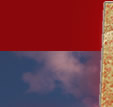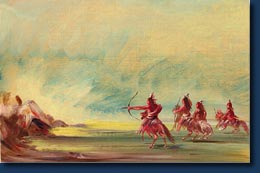|
Please take a minute to tell us what you think of
this site.
|
|
 |
 |
 |
 |
 |
 |
 |
 |
 |
 |
 |
 |
 |
 |
 |
 |
 |
 |
 |
 |
 |
 |
 |
 |
 |
 |
 |
 |
 |
 |
 |
 |
 |
 |
 |
 |
 |
 |
 |
 |
 |
 |
 |
 |
 |
 |
 |
 |
 |
 |
 |
 |
Texas is known around the world as a land of cowboys and Indians. Yet
the popular concept falls far short of the true extent of the cultures
of the state’s indigenous populations. Texas’ native tribes
built villages and pueblos, farmed the land, and joined extensive trade
networks. They developed oral histories and left records of their culture
through rock art.
Though different in many ways, these early Texans were united by an
appreciation of the rhythms of the sky. The skies were woven
into the cultural fabric of religion, politics, agriculture, and architecture.
Native groups used the Sun and stars to align their houses and
villages and to establish planting seasons. The Sun may have played a
role in the political and religious life of some East Texas villages,
where tribal leaders may have been seen as “Sun kings” And
the Sun, Moon, stars, and planets may be depicted in the rock art of West
Texas.
More » |

 Several
Texas Indian tribes, including the Osage, Wichita, and Comanche revered
meteorites. One trader reported that the Comanche rubbed their bodies
against one to cure illnesses. One iron-nickel meteorite known as
the Wichita Meteorite
may be depicted in Comanches Giving Arrows to the Medicine Rock, an
1834 painting by George Catlin that’s
now part of the collection of the Smithsonian American Art Museum. Several
Texas Indian tribes, including the Osage, Wichita, and Comanche revered
meteorites. One trader reported that the Comanche rubbed their bodies
against one to cure illnesses. One iron-nickel meteorite known as
the Wichita Meteorite
may be depicted in Comanches Giving Arrows to the Medicine Rock, an
1834 painting by George Catlin that’s
now part of the collection of the Smithsonian American Art Museum.
|
|
|

 Eileen
Thompson is an art teacher in the public schools in Fort
Stockton, Texas. In the mid ’90s she began studying
a site in the Davis Mountains known as the Cholla Site. Eileen
Thompson is an art teacher in the public schools in Fort
Stockton, Texas. In the mid ’90s she began studying
a site in the Davis Mountains known as the Cholla Site.
Read the full interview
Previous Experts: Sam
Wilson, Solveig
Turpin, Jeff Indeck |

|
 |

Texas Native Skies is a production of StarDate
Online. Copyright ©2004-05 The
University of Texas McDonald
Observatory |



